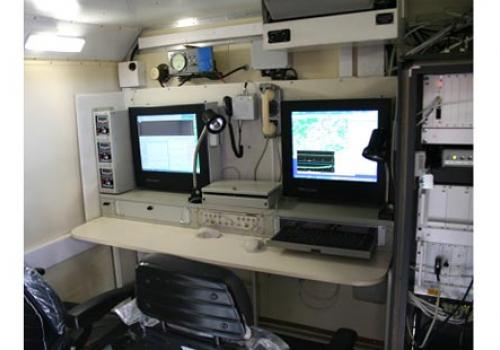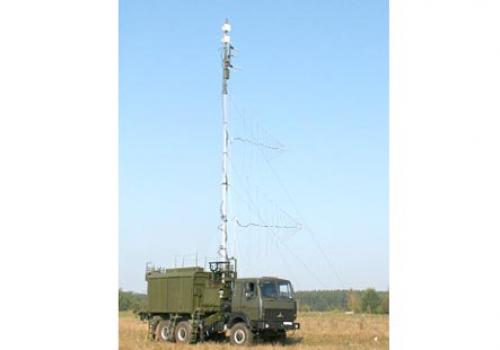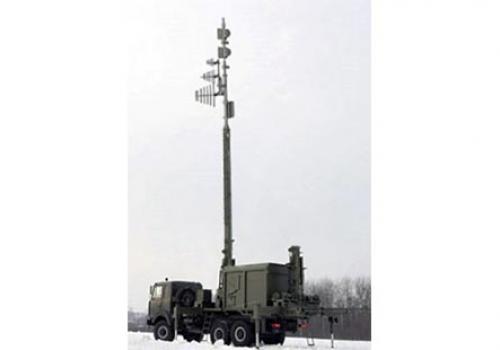“Purga” HF radio communication jammer
Radio reconnaissance designation of the system:
- automatic search, technical analysis, direction finding and detection of location (when operating as mated pair) of HF fixed-frequency and frequency hopping radio emission sources of tactical and strategic control links with distribution of signals by surface and space wave in the automatic link establishment mode and in the pre-programmed frequency hopping mode with the speed up to 300 hops/s;
- reception and decoding of “Mode-S” identification signals of aerial platforms, trajectory imaging of aerial platforms radiating “Mode-S” signals;
- transfer of radio reconnaissance data to the control post and reception of target designations from the control post (the control post is not included in the “Pourga” jammer delivery set, the delivery of the control post is reasonable for delivery of four or more jammers).
Jamming designation of the system: jamming of ground and aviation HF radio communication links:
a) simultaneous jamming of up to 4 fixed-frequency links operating within a single transmitter letter-designated frequency;
b) simultaneous jamming of one frequency-hopping net with up to 200 hops-per-second rate within a single transmitter letter-designated frequency.
Capabilities
• Control of radio electronic situation within the range of radio visibility, i.e. up to 40-50 km for ground targets and up to 450 km for air targets (with a flight altitude of more than 2,000 m) and at distance up to 2000 km by spatial wave.
• Search, detection and direction finding of new sources of radio emission in predetermined parts of the frequency range 1,5-30 MHz.
• Measurement of signals parameters of detected radio emission sources.
• Monitoring the operation of known emission sources put for observation.
• Disclosure of the modes of emission sources operating at fixed frequencies and in the frequency hopping mode, with the selection of individual sources within the frequency-bearing panorama.
• Assignment of frequencies for maintaining radio suppression: automatically, by the operator or by command from the control point.
• Automatic control of the operation of radio emission sources predetermined for suppression.
• Quasi-simultaneous emission of interference signals up to 4 selected frequencies, taking into account priority within the sub-range of one radio transmitter letter.
• Generation of interference signals corresponding to the type of modulation of the monitored signals.
• Suppression of a single network with pre-programed radio frequency hopping with the speed up to 200 times per second within the sub-range of one transmitter letter.
• Creation and transmission of reports on the results of control and suppression to the control point.
• Registration of signals at the output of the auditory control receiver.
• Technical analysis of signals of radio emission sources on a time scale close to real.
• Determination of coordinates of the location of radio emission sources with the display on the map when two stations operate in the mated pair.
• Control of parameters and modes of operation, collection of information from the secondary station of the mated pair to the primary station.
• Automated data processing and documentation.
Main technical characteristics
| № |
Characteristic |
Value |
| 1 |
Radio reconnaissance operating frequency band |
1,5–30 MHz |
| 2 |
Jamming working frequency band |
1,5–30 MHz |
| 3 |
Quantity of radio transmitter sub-ranges (letters), not more than |
6 |
| 4 |
and output power while operating with the agreed load of 50 Ohm, not less than |
5000 W |
| 5 |
Mean-square error of direction finding, not more than |
3° |
| 6 |
Peak sensitivity of radio receiving device (RX) of the detector/direction-finder, not worse than: |
2 mcV |
| 7 |
RX dynamic band in a two-signal mode for 2.5 kHz detuning between frequencies, not less than |
60 dB |
| 8 |
Simultaneous scanning bandwidth, not less than |
28,5 MHz |
| 9 |
Frequency scan rate in simultaneous scanning bandwidth, not less than: |
2 GHz/s |
| 10 |
Accuracy of determination of average signal spectrum frequency, not worse than |
100 Hz |
| 11 |
Radio reconnaissance of frequency-hopping links, maximum number of hops/s |
300 hops/s |
| 12 |
Level of high harmonic components of the jamming signal, not more than |
minus 60 dB |
| 13 |
Types of generated interferences: |
|
|
- aimed frequency modulated by noise |
yes |
|
|
- aimed phase-manipulated |
yes |
|
|
- aimed frequency manipulated |
yes |
|
|
- jamming noise in the band up to 20-100 MHz (depending on the letter) |
yes |
|
|
- other types of interferences at the Customer’s request |
yes |
|
| 14 |
Frequency ranges of beam transmitting antennas: |
|
|
- surface wave |
1,5-30 MHz |
|
|
- ionosphere wave |
1,5–12 MHz, 12–30 MHz |
|
| 15 |
Transmitting antenna gains not less than |
3 dB |
| 16 |
Station setup and teardown time not less than |
45 min |
| 17 |
Station power supply: |
|
|
- industrial network of three-phase AC 380 V, 50 Hz |
yes |
|
|
- industrial network of one-phase AC220 V, 50 Hz (onle hardware No 1) |
yes |
|
|
- diesel generator of three-phaze AC 380 V, 50 Hz |
yes |
|
Main features
• Maximum scanning speed within the frequency range up to 2 GHz/s.
• Correlation-interferometric method of direction finding, which provides detection and direction finding of pulse and pre-programed radio frequency hopping signals of duration not less than 3 ms.
• Measurement of parameters of radio signals.
• Automatic determination of coordinates of radio emission sources when there are two jamming stations “Purga” as mated pair.
• Use of modern technologies of digital synthesis while generating jamming signals that provide radio suppression of communication links in the pre-programed radio frequency hopping mode up to 200 hops per second.
• Radio transmitter power not less than 5 kW.
• Use of quickly erected antenna mast devices provides short setup and teardown time of the station.




